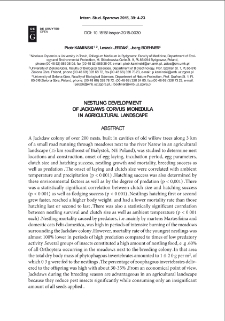Zielonogórska Biblioteka Cyfrowa udostępnia 65 391 obiektów cyfrowych
Obiekt
Tytuł: Nestling development of Jackdaws "Corvus monedula" in agricultural landscape
Tytuł publikacji grupowej:
Abstract:
A Jackdaw colony of over 200 nests, built in cavities of old willow trees along 3 km of a mall road running through meadows next to the river Narew in an agricultural landscape (15 km southwest of Białystok, NE Poland), was studied to determine nest locations and construction, onset of egg laying, incubation period, egg parameters, clutch size and hatching success, nestling growth and mortality, breeding success as well as predation. ; The onset of laying and clutch size were correlated with ambient temperature and precipitation (p < 0.001). Hatching success was also determined by these environmental factors as well as by the degree of predation (p < 0,001). There was a statistically significant correlation between clutch size and hatching success (p < 0.001) as well as fledging success (p < 0.001). Nestlings hatching first or second grew faster, reached a higher body weight, and had a lower mortality rate than those hatching last or second to last. ; There was also a statistically significant correlation between nestling survival and clutch size as well as ambient temperature (p < 0.001 each).Nestling mortality caused by predators, i.e. mainly by martens "Martes foina" and domestic cats "Felis domestica", was high in periods of intensive burning of the meadows surrounding the Jackdaw colony. However, mortality rate of the youngest nestlings was almost 100% lower in periods of high predation compared to times of low predatory activity. ; Several groups of insects constituted a high amount of nestling food, e.g.60% of all "Orthoptera" occurring in the meadows next to the breeding colony.In that area the total dry body mass of phytophagous invertebrates amounted to 1.4-2.0 g per m2, of which 0.3 g were fed to the nestlings. The percentage of zoophagous invertebrates deliv?ered to the offspring was high with about 30-35%. From an economical point of view, Jackdaws during the breeding season are advantageous in an agricultural landscape because they reduce pest insects significantly while consuming only an insignificant amount of all seeds applied.
Wydawca:
Zielona Góra: University of Zielona Góra, Faculty of Biological Sciences
Format:
Identyfikator zasobu:
DOI:
Strony:
Źródło:
International Studies on Sparrows, vol. 39
Jezyk:
Prawa do dysponowania publikacją:
Biblioteka Uniwersytetu Zielonogórskiego
Kolekcje, do których przypisany jest obiekt:
- Zielonogórska Biblioteka Cyfrowa > Repozytorium > Jednostki organizacyjne > Wydział Nauk Biologicznych
- Zielonogórska Biblioteka Cyfrowa > Repozytorium > Typy utworów > Artykuły
- Zielonogórska Biblioteka Cyfrowa > Repozytorium > Czasopisma naukowe i serie wydawnicze UZ > International Studies on Sparrows
Data ostatniej modyfikacji:
23 maj 2023
Data dodania obiektu:
9 maj 2023
Liczba wyświetleń treści obiektu:
179
Wszystkie dostępne wersje tego obiektu:
https://www.zbc.uz.zgora.pl/publication/81618
Wyświetl opis w formacie RDF:
Wyświetl opis w formacie OAI-PMH:
| Nazwa wydania | Data |
|---|---|
| Nestling development of Jackdaws "Corvus monedula" in agricultural landscape | 23 maj 2023 |
Obiekty Podobne
Czechowski, Paweł Kurzaj, Michał Jerzak, Leszek
Jerzak, Leszek Ciebiera, Olaf Boehner, Joerg
Ciebiera, Olaf Gajda, Krzysztof Stamm, Arkadiusz Szczepaniak, Katarzyna Cieniuch, Paweł Zajdel, Monika Czechowski, Paweł
Jerzak, Leszek Toczewski, Andrzej (1947- ) - red.
Świta, Piotr Kamiński, Marcin Jurczak, Paweł - red.
Jerzak, Leszek Ciebiera, Olaf Bocheński, Marcin
Gabryś, Grzegorz Jerzak, Leszek Gabryś, Beata Greinert, Andrzej - red.

